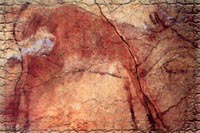
(6) Proto-Euskara or Aitzineuskara (Ancient Euskara): The eminent Basque language researcher, Koldo Mitxelena, was the precursor of the Proto-Euskara development and to whom we owe most of its knowledge. He places the Proto-Euskara reconstruction in the zero year or in 500 B.C. at most. That is to say, a few centuries before Archaic Euskara or Aquitanian, which was written on stone plaques.
Proto-Basque had five standard vowels: a, e, i, o, u (the same as the current ones) and its diphthongs were ai, ei, oi, ui, au, eu, the same as in current Euskara.
Regarding the semivowels, which are often phonetically represented by j, y and w, did not exist in Proto-Basque. The consonants that formed a systematic body were the following ones:
|
Strong |
(p) t k tz ts N L R |
|
Weak |
b d g z s n l r |
Furthermore, there was the 'h' which was very frequent, although its presence has gradually disappeared in the modern dialects. As we can see in the table above, the consonant 'p' is listed between brackets because it hardly existed in Proto-Basque. There is no 'm' (except any consonant derived from a former 'b') nor 'f'. The consonants that are pronounced on top of the palate (the ones that are written like tt, dd, tx, x, ñ, ll) and that in current Euskara are used to create expressive words (diminutives or tender words) perhaps existed in Proto-Euskara as well.
Both rows of consonants in the table, strong and weak, differ in that the upper ones were pronounced stronger than the lower ones and lasted a bit longer. With regard to the three left columns, note that the three lower consonants (b, d, g) were pronounced without shutting the lips and making the vocal cords vibrate, in contrast to the upper ones (p, t, k).
During the early centuries of the Christian era, when Proto-Euskara changed to Euskara, the strong consonants N and L started to be confused with the weak 'n' and 'l'. On the other hand, the consonants 'p', 't' and 'k' became similar to 'b', 'd' and 'g' in strength except for the factors mentioned above. In Proto-Euskara, only the weak consonants could go at the beginning of the word and the strong ones were placed at the end of it. Thus, the alternation of strong and weak consonants was only possible in the middle of the word.
A Basque archaic word cannot also be started by 'd' (this is only possible in some verbal forms in present tense by influence of an old adverb) nor 'r'. In addition to this, if the 'm' is hardly found, a word with this consonant at the beginning of it would be impossible to find except in any Celtic loan. Nor are there words that start with two consecutive consonants. The words were always started by vowels or the above-listed consonants (b, g, z, s, n, l ) as well as 'h'.
The nouns and the adjectives were especially two-syllabled and the verbs were monosyllabic. The article did not exist (it is thought that it was introduced in Eukara during the Middle Ages by the influence of the Romance languages. The Basque article '-a' comes from the demonstrative 'har-')
Joseba Andoni Lakarra, who developed the Basque language prior to Proto-Euskara (what in Basque philology is known as 'Pre-Proto-Euskara'), indicates that before the Proto-Euskara period, the Basque language showed signs of being a language with a few or without declensions, as well as isolating (7). Furthermore, the verb that currently goes at the end of the sentence, would have gone at the beginning of it in Pre-Proto-Euskara.
 (7) Isolating language: each word has a single meaning. For example, Castilian is not an isolating language because there are words like "vinieron" (they came), which includes three meanings: 'to come', past tense and 'they'. On the other hand, in Vietnamese, which is an isolating language, each of those meanings are expressed with different words. Castilian is as well a fusional or inflecting language since the three meanings of 'vinieron' are fused in a single word that is difficult to segment. Those languages can be more synthetic like Latin, in which the declension is the main property or more analytic like the Romance languages, in which prepositions are their most important feature.
(7) Isolating language: each word has a single meaning. For example, Castilian is not an isolating language because there are words like "vinieron" (they came), which includes three meanings: 'to come', past tense and 'they'. On the other hand, in Vietnamese, which is an isolating language, each of those meanings are expressed with different words. Castilian is as well a fusional or inflecting language since the three meanings of 'vinieron' are fused in a single word that is difficult to segment. Those languages can be more synthetic like Latin, in which the declension is the main property or more analytic like the Romance languages, in which prepositions are their most important feature.
Share this page!

